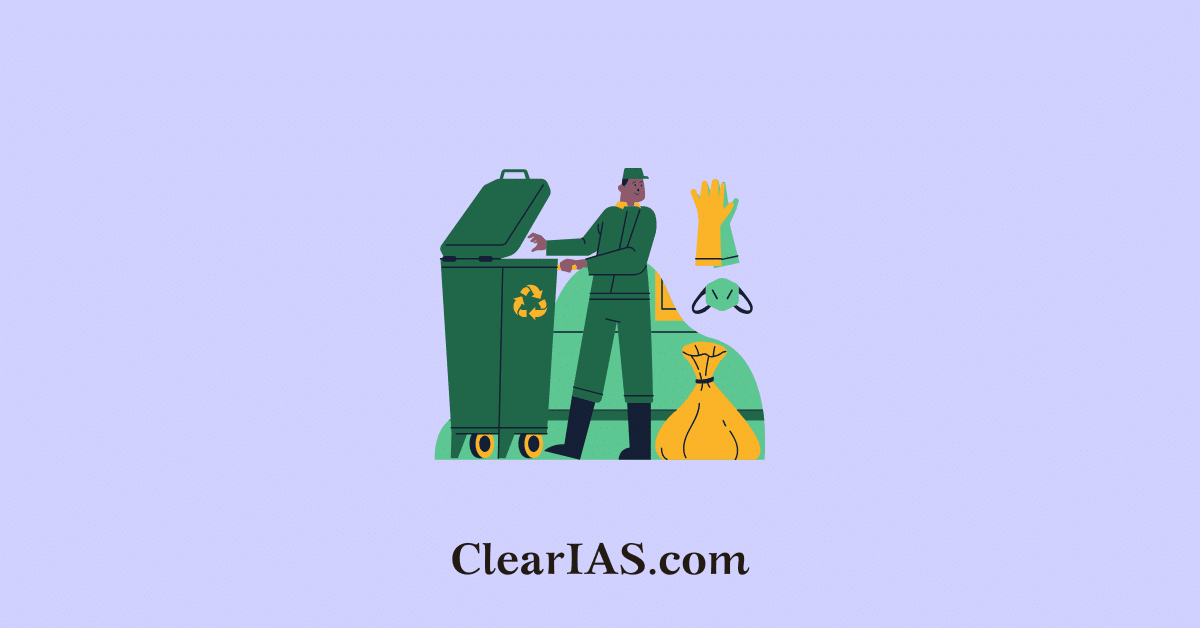
One of the most neglected issues in India’s environmental governance has been the management of chemically contaminated sites. In these areas, past industrial activities have left toxic residues in soil, groundwater, and surface water. Read here to learn about the newly notified rules.
Industrialisation has been a cornerstone of India’s economic development, but it has also left behind an environmental legacy of pollution and hazardous waste.
Until recently, India lacked a comprehensive legal framework to address such sites, despite their clear risks to human health and ecosystems.
In August 2025, the Ministry of Environment, Forest and Climate Change (MoEFCC) notified the Environment Protection (Management of Contaminated Sites) Rules, 2025 under the Environment (Protection) Act, 1986.
This marks the first formal legal structure dedicated to systematically identifying, assessing, and remediating contaminated sites nationwide.
What are Chemically Contaminated Sites?
According to the Central Pollution Control Board (CPCB), contaminated sites are areas where hazardous or other wastes have been historically dumped, stored, treated, or mishandled, leading to contamination of:
- Soil
- Groundwater
- Surface water
- Sediments
Such contamination may arise from:
- Old industrial plants (tanneries, dyeing units, pesticide factories, chemical industries).
- Abandoned landfills or waste dumps.
- Spill-sites involving petroleum or hazardous chemicals.
- Waste storage and treatment sites without proper liners or leachate management.
These sites are often legacy pollution hotspots, developed when there was no strict regulation on hazardous waste management.
Many polluters have since shut operations, leaving remediation costs to the public.
The Scale of the Problem in India
- 103 sites identified across the country by CPCB.
- Only 7 sites have initiated remediation operations.
- Contamination hotspots exist in industrial belts such as Kanpur (UP), Vapi (Gujarat), Patancheru (Telangana), Ranipet (Tamil Nadu), and the Ganga-Yamuna basin.
- Many sites are located near dense human settlements, increasing exposure risks.
Health and Environmental Risks:
- Direct human health impacts: cancers, neurological disorders, reproductive issues, and chronic diseases from long-term exposure to toxic metals (like lead, chromium, cadmium) or organic pollutants (like pesticides, PCBs).
- Ecological damage: contamination disrupts soil microbes, destroys aquatic life, and can make land unfit for agriculture for decades.
- Water safety risks: toxic leachates pollute groundwater—a major drinking water source for rural India.
The 2025 Rules: A New Regulatory Framework
The Environment Protection (Management of Contaminated Sites) Rules, 2025, bring clarity and structure to a process that was previously ad hoc.
Key Features:
- Identification and Notification of Sites
- States/UTs, SPCBs, and CPCB to maintain inventories of suspected contaminated sites.
- Sites to be categorised based on preliminary risk assessments.
- Detailed Site Investigation
- Scientific sampling of soil, groundwater, and sediments.
- Risk characterisation to determine urgency and type of remediation.
- Remediation Planning
- Preparation of Remediation Action Plans (RAPs) using appropriate technologies (e.g., soil washing, thermal desorption, bioremediation).
- Public consultation before finalising plans.
- Implementation and Monitoring
- MoEFCC to oversee implementation.
- SPCBs to ensure monitoring and compliance.
- Periodic progress reports to be submitted to CPCB.
- Liability and Cost Recovery
- Polluter Pays Principle: Where polluters are identifiable, costs must be borne by them.
- In cases where polluters no longer exist or are insolvent, public funds may be used.
Tasks under the Capacity Building Program for Industrial Pollution Management Project (CBIPMP)
This was implemented earlier with World Bank assistance.
The CBIPMP aimed to develop institutional and technical capacity in managing legacy pollution and chemically contaminated sites.
Major Tasks
- Inventory & Prioritisation
- Prepare a national inventory of contaminated sites.
- Prioritise sites for remediation based on risk to health and the environment.
- Site Assessment & Risk Analysis
- Conduct detailed site investigations.
- Assess the extent of contamination (soil, groundwater, sediment).
- Perform human health and ecological risk assessments.
- Demonstration Remediation Projects
- Pilot remediation technologies at select sites (e.g., Ranipet, Andhra Pradesh industrial areas).
- Develop cost-effective, replicable models.
- Institutional Strengthening
- Build capacity in State Pollution Control Boards (SPCBs) & Central Pollution Control Board (CPCB).
- Establish protocols for monitoring, enforcement, and remediation planning.
- Policy & Regulatory Development
- Formulate guidelines for contaminated site management.
- Propose legal frameworks (precursor to the 2025 Rules).
Challenges in Implementation
Despite the new rules, India faces several hurdles:
- Data Gaps: Many contaminated sites remain unidentified due to poor environmental monitoring.
- High Remediation Costs: Clean-up can cost ₹5-50 crore per site, depending on contamination depth and area.
- Technological Limitations: Limited availability of in-country expertise for advanced remediation technologies.
- Liability Enforcement: Difficulty in tracing polluters, especially for sites decades old.
- Coordination Issues: Multiple agencies (MoEFCC, SPCBs, Urban Local Bodies) must collaborate, which can delay action.
Way Forward
- Strengthen Inventories: Use satellite imaging, GIS mapping, and AI-driven risk prediction to locate potential contaminated sites.
- Dedicated Remediation Fund: Establish a National Legacy Pollution Fund financed through environmental cess, corporate contributions, and green bonds.
- Public-Private Partnerships: Encourage private investment in remediation through carbon credits, land value capture, and tax incentives.
- Capacity Building: Train state and municipal officers in risk assessment and remediation techniques.
- Community Engagement: Involve affected communities in site monitoring, decision-making, and post-remediation land use.
- Link with Climate and Health Goals: Integrate remediation into National Adaptation Plans and public health missions, recognising that contamination also increases vulnerability to climate impacts.
Conclusion
The Environment Protection (Management of Contaminated Sites) Rules, 2025 mark a watershed moment in India’s environmental governance.
They not only provide a legal basis for managing toxic legacies but also align India with global environmental practices.
However, the success of these rules will depend on robust implementation, adequate funding, technological innovation, and inter-agency coordination.
The lessons from the CBIPMP show that while remediation is possible, it requires long-term commitment, sustained financing, and strong institutional capacity.
In a country where industrialisation is rapidly expanding, proactive contaminated site management is not just an environmental imperative; it is a public health necessity.







Leave a Reply